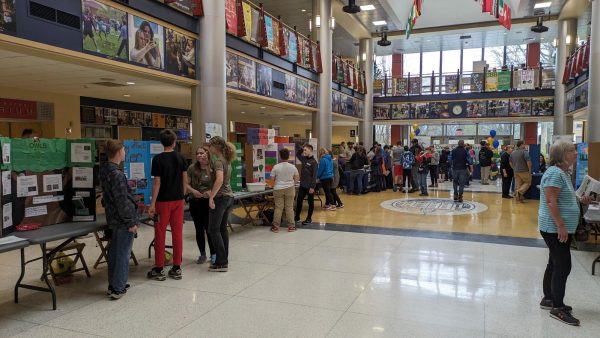Green Boxes: eliminating individual waste
On Friday, Sept. 20, students organized across almost 150 countries to participate in the Global Climate Strike. Swedish teenage activist Greta Thunberg has become a powerful voice for students that are determined to fight for their future in the age of climate change.
Allegheny College students were among the millions of young adults that participated in the global strike. As the strike demonstrated, citizens across the world are recognizing the need to slow the climate crisis, and therefore are beginning to incorporate everyday, environmentally-friendly practices into their lives.
Eliminating the use of single use products, thus cutting back on individual consumption, is a step that Kelly Boulton, sustainability coordinator at Allegheny College, has been focusing on for many years. Incorporating the green box system is one way Allegheny has been able to cut back on individual waste consumption.
Single use products take a significant amount of energy and water to produce, only to be thrown away after one use. One single use product per day for 365 days, multiplied by 1,800 Allegheny College students amounts to a substantial amount of waste, according to Boulton. She said that going beyond the mindset of “it is just this one time” can help shift student habits and limit waste on campus.
Although the products that Parkhurst Dining provide are compostable, only products that are thrown in the compost section of McKinley’s Food Court make it to the campus composter. Even then, the amount of dry waste from to-go containers outweighs that of wet waste in Allegheny’s compost system, according to Allegheny Student Government Director of Sustainability and Environmental Affairs Cat Lord, ’20.
“When we start to visualize our impact on a bigger basis it makes us change our habits more quickly,” Boulton said.
The green box system involves a culture shift on Allegheny College’s campus amongst students. The process has required thoughtful execution from Boulton — the goal has been to phase the project in over time so that it is manageable and easily understood by students, according to Boulton.
For first time users of the system, the system can be intimidating. Some students can become overwhelmed about the number of steps in the process, according to Boulton.
“I think that is the biggest barrier is getting people to do it for the first time,” Lord said. “Then, people are like, ‘I could do this everyday.’”
Breaking it down into steps is a great way to start the process, according to Boulton. For students using green boxes for their first time at Brooks Dining Hall, they simply have to let the employee at the register know they have not used a green box yet and then swipe their card to indicate they have started the process. For students at McKinley’s, they begin by going to one of the stations, asking for a green box and having the box filled before checkout.
For the salad and cantina stations, students should let Parkhurst workers know that they would like a green box as soon as they arrive at the station because food will be put directly into the box. At the pasta and sandwich stations, students can wait through the line as their food is prepared and then ask for a green box.
Once students have used the green box, they will return it to Brooks or McKinley’s and receive a token. The next time they go to either dining hall, they will provide the token and be given a green box in exchange.
The goal for the future is to shift away from the token system to solely credit swipes, according to Boulton. There were weaknesses within the program in the first year of implementation, such as the loss of coins, Boulton said. Tabling and increased education about the system have been used to improve visibility of the system on campus, according to Students for Environmental Action President Kylie Wirebach, ’20.
One of the goals of the system is to reduce food waste on campus and shift away from the compostable boxes, and eventually use the green boxes more times than not.
When we start to visualize our impact on a bigger basis, it makes us change our habits more quickly.
— Kelly Boulton, Sustainability Coordinator, Allegheny College
By participating in the green box system, the campus could continue to expand initiatives to achieve climate neutrality by 2020, according to Lord. These small steps take place on an individual level, but ultimately create a whole culture shift on campus toward a more sustainable campus culture.
“In the morning, you grab your phone, (Allegheny) ID (card) and your keys, right? Why are you not also grabbing your token, water bottle and a coffee cup, … or your spork?” Boulton said.
Participating in programs such as the green box system is an everyday way to become involved in something much bigger than yourself. It is a simple system that reminds students that their actions contribute to a larger ecological footprint. Now more than ever, being environmentally conscious at Allegheny is easy and essential.






